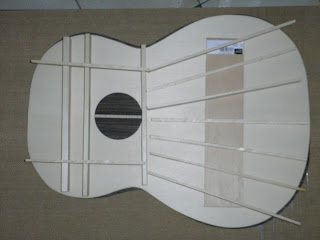Anyway I managed to do some more things:
- Bend the side back to shape to eliminate any spring back
- Shaving of braces to 7mm wide and 3mm tall (Torres fan)
- Plane the topboard to between 2 to 3 mm thick
Side Bending
I use the Aluminium pipe coupled with the heat gun to bend the sides.
To bend the side the heat gun have to set to about 75% full power which is quite hot.
Without a thermometer I can't really tell how hot it is, but I guess its quite hot but not as hot as stove. (Because I bend w/o wearing any glove)
Now as a safety precaution, you should always use a glove to bend.
The hardest part of the bend, was the waist.
I let the gun blow hot air onto the waist to heat it up.
Then I slowly press onto the heat pipe and rock the sides around the heat pipe.
No spraying of water was used as I found it to be unnecessary.
Well I nearly crack the piece, but luckily stop in time to prevent the cracking.
After a few rounds, the waist conforms to the acrylic template which I take as reference.
Then I bend the lower bout to reduce the spring back and then the upper bout.
It was fun; I have never felt more satisfied with myself.
Here is the side after the bend.
There is virtually no spring back, only slightly open at the both ends.

Compare with the previous picture, the spring back was pretty bad.

Bracing
For the bracing, after so many rounds of consideration, I decided on the Torres fan bracing pattern.
The braces are 7mm wide by 3mm and so I began to shave down the braces to size.
I never regretted acquiring the Stanley block planes.
It really makes the whole planing process a joy.
Top
Finally, I manage to thin down the top.
When it came it was abt 3.x mm thick.
I dont have a thickness dial gauge so I cant tell you the exact thickness.
The only measurement was at the edge using a veneer caliper.
After planing I measured the edge was about 2mm. The center which I leave it slight thicker should be between 2 to 3 mm.
Adjusting the stanley block plane was fairly easy.
Using the block plane, I managed to thin out the top board and smoothen it using a scraper.
Here is the braces and the top after the work.

What's next
I think the whole thing is ready for some bracing action.
All I need next, is either one of the 3:
- Get some weights
- Building cam clamp
- Building a screw system
- Building a go-bar deck
Weights
The easiest of them all and requires no building.
However to get dense weight w/o occupying a large area is quite hard to find.
I tried several stationary shops around they don't seem to carry any paper weights...
Cam Clamp
Previously, I had bought some Aluminium bar from the Kelantan Lane.
They were meant for building cam clamps.
However, building cam clamps is a tedious process and I need to source for the wood.
I think I will leave at it for the moment.
Screw System
I was thinking of getting a metal bar across the top board and use a screw and bolt to press down on the brace while gluing.
This is a pretty fast method of building but involves some careful design consideration
I need to acquire alot of screws which may add up quite a bit of cost.
Also it need some making for the screw to attach to the bar and press against the braces.
Go-bar Deck
Finally, the proven go-bar deck system.
I will be acquiring some plywood from a local supplier Chiang Leng Hup Plywood
for about SGD20 a piece for a 2m x 1m x 1cm plywood.
If you are interested you can contact them for the quotes.
The staff are very friendly to deal with.
For the go-bar deck, I just need to do the following:
- Saw the plywood into 2 2 foot square (60cm).
- For the rest of the wood, it will be used as "braces" to support the plywood.
The stress on the plywood is quite great, enough to bend the whole board.
- Drill 4 holes at the edge for the metal support.
- Saw 2 screw rods into halves (which I have acquired previously) (1m each)
I need four of them; 1 for each corner
- Reinforce the board with the struts (glue or nail or screw)
- Assemble the deck accordingly.
For the go-bar itself, I will be sawing some bamboo pole in length excess of the deck height.
Once the deck is up it's easy to add new go-bars, which is the main reason why I will opting for this method of clamping.
Now to acquire the plywood 1st.
Bridge blank
I bought some padauk bridge turning wood for making the bridge, which is an African hardwood.
The turning square is enough to make 3 bridges.
(See the LMI bridge blank compare to the turning square)
According to many makers, paduak is a lighter material compare to rosewood.
The famous Australian maker Greg Smallman is also using paduak bridges to reduce the weight on the top.












































